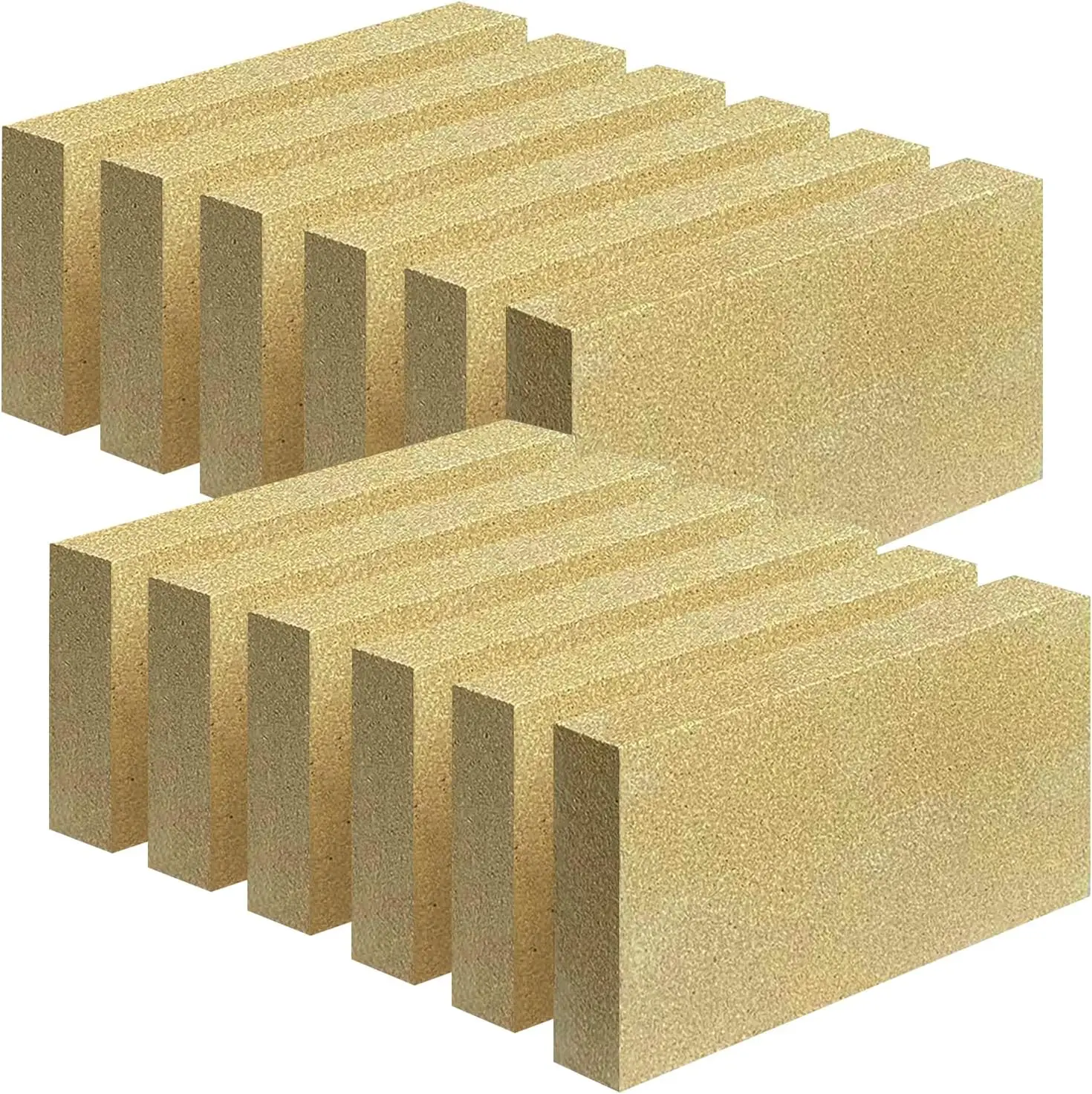When it comes to heating your home during the colder months, many people rely on wood heaters for their warmth and comfort. But if you’re looking to enhance your wood stove’s efficiency, you may have come across heat bricks as an option. The question is, are heat bricks for wood heaters really worth it?
In this article, we’ll dive into the pros and cons of heat bricks to help you decide if they’re the right choice for your home.
What Are Heat Bricks?
Heat bricks, also known as firebricks or refractory bricks, are dense ceramic or compressed wood blocks specifically designed to withstand high temperatures. They are commonly used in wood heaters, fireplaces, and stoves to improve heat retention and efficiency.
These bricks are made to absorb heat from the fire and release it slowly, helping to maintain a consistent temperature in your home.
Types of Heat Bricks
| Type of Heat Brick | Description | Common Uses | Key Properties |
|---|---|---|---|
| Refractory Bricks | High-temperature resistant bricks. | Ovens, kilns, furnaces. | Durable, low thermal conductivity. |
| Fire Bricks | Subtype of refractory bricks. | Fireplaces, industrial kilns. | Non-flammable, heat retention. |
| High-Alumina Bricks | Contains high alumina content. | Steelmaking, cement kilns. | Withstands over 1,600°C (2,912°F). |
| Magnesia Bricks | Made from magnesia; basic environment. | Steelmaking, furnace linings. | High melting point, thermal shock resistant. |
| Neutral Refractory Bricks | Resists both acidic and basic conditions. | Industrial furnaces. | Versatile in harsh environments. |
| Insulating Fire Bricks | Lightweight and insulating. | Kilns, high-temp applications. | Low density, excellent insulation. |
Are Heat Bricks for Wood Heaters Worth It?
Yes, heat bricks for wood heaters and stoves can be a worthwhile investment, offering several key advantages. They are highly efficient in heat retention, absorbing and storing heat to release it gradually, which helps maintain a consistent temperature in the room for longer periods.
These firebricks protect the stove’s interior, particularly the floor, from extreme temperatures, preventing damage and ultimately extending the lifespan of the stove.
This improved heat distribution can enhance combustion efficiency in stoves designed to utilize them.
However, there are some downsides to consider. The initial cost of installing heat bricks can be significant, and their weight may require more space within the stove, potentially limiting design flexibility.
Some users have also noted that heat bricks might reduce immediate heat output in certain setups, leading to a slower warming process.
High Temperature Insulated Firebricks for Wood Stoves, Fireplaces

- PERFECT FOR WOOD STOVES AND FIREPLACES
- INSULATING MATERIAL
- DURABLE AND LONG-LASTING
- EASY TO INSTALL
How Do Heat Bricks Work in Wood Heaters?
Heat bricks work by absorbing the intense heat generated in a wood stove and slowly releasing that heat over time. They improve combustion efficiency by maintaining a higher internal temperature, which allows the fire to burn more thoroughly and reduces waste.
The thermal mass of these bricks helps to keep your home warmer for longer, even after the fire has died down.
In simpler terms, fire bricks act like a thermal battery. They soak up heat when the fire is roaring and continue to radiate warmth long after the flames have gone out.
Which Type of Fire Bricks Should I Use for My Wood Stove?
| Type of Fire Brick | Size (inches) | BTU Output | Temperature Resistance | Best Use |
|---|---|---|---|---|
| Standard Fire Bricks | 9 x 4.5 x 2.5 | Up to 30,000 BTU/hour | Up to 2,700°F (1,480°C) | Firebox lining |
| Insulating Fire Bricks | 9 x 4.5 x 1.25 | Varies, enhances efficiency | Up to 2,300°F (1,260°C) | Outer layers for insulation |
| Vermiculite Fire Bricks | 9 x 4.5 x 1.5 | Varies, improves heat retention | Up to 2,000°F (1,093°C) | Surrounding firebox |
| High-Alumina Bricks | 9 x 4.5 x 2.5 | Up to 30,000 BTU/hour | Over 2,600°F (1,427°C) | High-temperature applications |
| Split Fire Bricks | 9 x 4.5 x 1.25 | Varies based on application | Up to 2,700°F (1,480°C) | Custom applications and repairs |
When selecting fire bricks for your wood stove, it’s essential to consider factors such as material, density, size, and compatibility with your stove model. Vermiculite fire bricks are a popular choice due to their excellent insulating properties, which help prevent heat loss and ensure efficient burning.
They are precision-cut for optimal fit and performance in wood-burning and multifuel stoves. Another important aspect is the density of the fire bricks.
Higher density bricks, like those from Alsey Refractories Co., offer superior strength and heat retention, making them more durable and less prone to cracking compared to lower density options. For most applications, a heavy-density fire brick (approximately 9″ x 4.5″ x 1.25″) is recommended as it can withstand the intense heat generated during combustion.
It’s also crucial to ensure that the fire bricks match the dimensions of your stove’s firebox. Measuring the existing bricks or the firebox itself will help you select the right size. Some manufacturers offer custom-cut options for a perfect fit.
Pros of Using Heat Bricks in Wood Heaters
1. Increased Heat Efficiency
One of the biggest advantages of using heat bricks is that they improve the overall efficiency of your wood heater. By retaining heat for longer periods, they help maintain a consistent temperature in your home, reducing the need to keep adding logs to the fire.
2. Extended Heating Duration
With heat bricks in place, your wood heater will continue to radiate warmth for hours after the fire has died out. This extended heating period can be a game-changer, especially during cold nights when you don’t want to get up to stoke the fire.
3. Cost-Effectiveness
While there is an upfront cost to purchasing heat bricks, they can save you money in the long run by reducing the amount of firewood you need to use. Also, compressed wood bricks can be a cost-effective alternative to traditional firewood.
4. Environmentally Friendly Option
Compressed wood bricks, in particular, are made from recycled wood waste, making them an eco-friendly option for heating your home.
They produce less ash and fewer emissions compared to regular firewood, which can be a plus for environmentally conscious homeowners.
5. Reduced Creosote Buildup
Creosote is a tar-like substance that builds up in chimneys and can pose a fire hazard. By improving combustion efficiency, heat bricks can help reduce the amount of creosote that forms, making your wood heater safer to use.
Cons of Using Heat Bricks in Wood Heaters
1. Initial Cost of Purchasing Heat Bricks
The initial investment in heat bricks can be higher than the cost of regular firewood. Depending on the type and quantity, they can be expensive, which may deter some homeowners from making the switch.
2. Risk of Cracking
Over time, heat bricks can crack due to repeated exposure to high temperatures. Cracks can compromise their effectiveness and may require replacement sooner than expected.
3. Compatibility Issues with Some Wood Stoves
Not all wood stoves are designed to accommodate heat bricks. Some models may require specific types or sizes of bricks, so it’s important to check your stove’s specifications before purchasing.
4. Maintenance Requirements
While heat bricks are generally low maintenance, they do require periodic inspection for cracks and damages. Regular cleaning is also necessary to ensure they remain effective.
Do Fire Bricks Save Money on Heating Costs?
One of the most common reasons homeowners consider using heat bricks is the potential cost savings. So, do heat bricks actually help reduce heating expenses?
The answer depends on how you use them. Here’s a breakdown of the cost factors:
- Firebricks and Refractory Bricks: These heat bricks can help reduce firewood consumption by retaining heat longer. This means you won’t need to add as much wood to your fire, saving money in the long run.
- Compressed Wood Bricks: These can be a more affordable alternative to firewood. They burn longer and hotter, reducing the number of bricks needed to heat your home.
However, the initial investment in heat bricks can be costly. You’ll need to balance the upfront cost with the long-term savings on firewood or fuel.
How to Properly Use Heat Bricks in Your Wood Heater
To get the most out of your heat bricks, proper usage is essential. Here are some tips:
1. Placement Tips
- Place firebricks or refractory bricks along the walls of your wood heater to help retain heat.
- Compressed wood bricks should be placed on the fire grate, not directly on the floor of the heater, to ensure proper airflow.
2. Usage Practices
- Start with a small fire using traditional kindling and firewood.
- Once the fire is established, add compressed wood bricks to maintain the heat.
- Avoid overloading the heater with too many bricks at once, as this can reduce airflow and affect combustion.
Heat Brick Durability: How Long Do They Last?
The lifespan of heat bricks depends on the type and how well they’re maintained:
-
Firebricks: Typically last between 5 to 10 years, depending on usage and maintenance.
-
Refractory Bricks: Can last longer than firebricks, often up to 15 years.
-
Compressed Wood Bricks: These are consumable and are used as fuel, so their lifespan depends on how frequently you burn them.
Keep in mind that extreme temperature changes can cause heat bricks to crack over time. Regular inspections and timely replacements can extend their lifespan.
Are Heat Bricks Safe to Use in All Wood Heaters?
While heat bricks can enhance the performance of most wood heaters, they may not be suitable for all models. Always check your stove’s user manual for compatibility before adding heat bricks.
Safety Precautions:
-
Ensure your wood heater is designed to handle the additional thermal mass of firebricks or refractory bricks.
-
Avoid using cracked or damaged heat bricks, as they can cause hot spots and reduce efficiency.
-
Never block air vents or grates with heat bricks, as this can hinder combustion and pose a safety risk.
User Reviews and Experiences with Heat Bricks
Real-life experiences can offer valuable insights into whether heat bricks are worth it. Here’s what some users have to say:
Positive Feedback:
- “My compressed wood bricks burn longer than firewood, and I don’t have to keep feeding the fire all night.”
- “Using firebricks in my wood stove has reduced the amount of wood I need to use each winter.”
Common Complaints:
- “Some of my firebricks cracked after just one season.”
- “Compressed wood bricks don’t provide the same ambiance as traditional firewood.”
FAQs
Can I use heat bricks in any wood heater?
Not all wood heaters are compatible with heat bricks. Check your stove’s manual for guidance.
How often should I replace firebricks?
Firebricks typically last between 5 to 10 years, depending on usage and care.
Are compressed wood bricks better than firewood?
Compressed wood bricks are more eco-friendly and burn longer than traditional firewood, but some people prefer the ambiance of real wood.
Do heat bricks produce less ash?
Yes, compressed wood bricks tend to produce less ash compared to traditional firewood.
Can I make my own compressed wood bricks?
Yes, but it requires special equipment to properly compress the wood waste into durable bricks.
Affiliate Disclosure: Fireplaceadviser.com is a participant in the Amazon Services LLC Associates Program. We may earn a commission when you click on certain links on this site and purchase.

Hello!! I am Jamal Khan. I often fix my home electric heaters and gas stove problems and research the common issues in the heating units to improve my knowledge and expertise. The aim of establishing fireplaceadviser.com is to share my expertise and knowledge with my audience.












